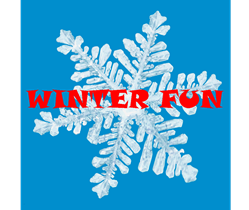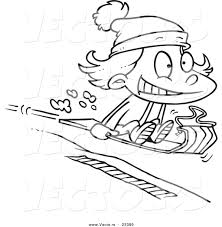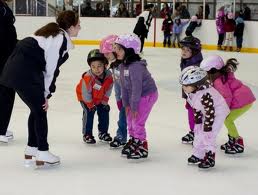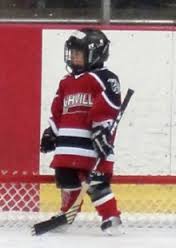
General Safety
- Set reasonable limits on outdoor play to prevent hypothermia and frostbite. Have children come inside periodically to warm up.
- Never let children play outside alone, establish a buddy system so they can look out for one another.
- Never go out in extreme weather, such as a snowstorm.
- Tell your children never to put their tongues on cold metal. It may sound silly, but some kids still do it.
- Discourage snowball fights. Snowball fights can lead to injuries, especially to the eyes. Snowballs are more dangerous if the snow is hard-packed or contains a rock or some other hard object.
- Children should not; play in snow banks, a snowplow or other vehicle may not see a child. Build snow forts and tunnels, they may collapse and suffocate a child.
- Using alcohol or drugs before any winter activity is dangerous and should not be permitted in any situation.
Sledding
Anywhere there is snow and a hillside, you can find people sledding. Sledding with friends and family members has been a winter ritual for generations. Sledders are most likely to be injured in collisions with objects or people. Sledding injuries can be very serious, resulting in broken bones and trauma to the abdomen, head, and neck. Here are some precautions to take when heading out for some snow fun.

Location
- Make sure you know the hill. If it is steep and covered with trees, it is not a good location for sledding.
- Watch out for hills with rocks or those near busy roads. Avoid hills that end near ponds, tress, fences, or other hazards.
- Choose hills that are snowy rather than icy. Icy slopes make for hard landings.
- Always sled during the day time, when visibility is better.
Dress for the Cold
- Wear sensible winter clothing – hats, gloves/mittens, snow pants, winter coat, snow boots – that is waterproof and warm.
- Don't wear scarves or clothing that can get caught in a sled and pose a risk of strangulation.
- Experts also suggest having kids wear helmets to help prevent head injuries. Helmets designed for winter sports work best, but if you don't have one, make sure they are at least wearing a bike helmet or something similar.
Best Sleds
The best sleds can be steered by their riders and have brakes to slow them down. Avoid sleds that can not be steered and never us a sled substitute like a lunch tray or cardboard box. Good sleds are relatively cheap to buy and are well worth the extra money.
Safety Rules
There are a few rules that should be followed to keep you and the other sledders safe.

- Be sure a responsible adult is present to supervise. In the event someone does get injured, there should always be an adult on hand to administer first aid and, if necessary, take the injured sledder to the emergency room. Call 911 for serious injuries, including neck or head injuries.
- Young kids (5 and under) should sled with an adult, and kids under 12 should be actively watched at all times.
- Children should always sit face-forward on their sleds. Never let them sled down a hill backwards or while standing, and make sure they don't go down the hill face-first, as this greatly increases the risk of a head injury.
- Insist that kids go down the hill one at a time and with only one person per sled (except for adults with young kids).
- Keep arms and legs within the sled at all times. If you fall off the sled, move out of the way as quickly as possible. If you are on a sled that won't stop, roll off it and get away from it.
- Walk up the side of the hill and leave the middle open for other sledders.
- Never ride a sled that is being pulled by a moving vehicle.
Ice Skating/Hockey
Ice skating and ice hockey are great cold-weather activities, following a few safety tips will help keep these activities safe and fun.
- Skate in areas that have been approved and posted for ice skating. Never awesome it is safe to skate on a lake or pond.
- Skate in the same direction as the crowd.
- Avoid darting across the ice.
- Consider having children wear a helmet, knee and elbow pads, especially while learning to skate.
- Make sure skates are comfortable, with good ankle support, to avoid twists, springs or breaks.
- Avoid skating alone; stay where others can see you. Make sure children are always supervised on ice.
- Never skate after dark.
- Before playing hockey, gear up. Never play a game of hockey without the following:

- Helmet – Helmets should be certified by the Hockey Equipment Certification Council (HECC) and should include a full face mask and fits properly.
- Skates – Be sure skates fit well and have plenty of ankle support.
- Pads – Use appropriate pads; shoulder, elbow, knee and shin pads are all specific to hockey.
- Gloves – Hockey gloves should allow for mobility while protecting well past your wrist.
- Athletic Supporter/Cup – These are incorporated into most hockey undershorts but can also come from other sports.
- Mouth Guard – These not only protect the teeth, but also the lips, cheeks, and tongue and can help prevent jaw injuries.
- Know how to skate before playing hockey.
- Skate the rink a few times before playing for warm up. Use this time to loosen up your joints and stretch your muscles.
- Keep safe during a game and play by the rules.
Sources: American Academy of Pediatrics (www.aap.org), Centers for Disease Control and Prevention (www.cdc.gov), and Kids Health (www.kidshealth.org)
